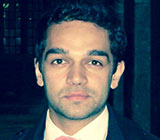 “Listen to the patient and they will tell you the diagnosis.”
“Listen to the patient and they will tell you the diagnosis.”
Widely attributed to Sir William Osler, this quote is often shared with new medical students, and I often find myself repeating it to the undergraduate clinical students I currently supervise. Regardless of the specialty area or examination skills we cover, clinical history taking remains a recurring topic in our tutorials.
When starting out as a medical student, taking a history from a patient can be a long and arduous process that often includes seemingly bizarre lines of enquiry, such as questions about how many pets the patient has. Thankfully, clinical experience and the time pressures of working as a junior doctor mean that this process is greatly streamlined over the years, and is gradually condensed down from taking 45 minutes to often two or less. Aside from the single smug diagnosis of pigeon fancier’s lung that doctors invariably make at some point in their career, the questions about pets tend to be largely obsolete.
Dissecting the art of history taking with my students prompted me to consider the part it actually plays in clinical life. As well as enquiring about symptoms, patient histories help us appreciate any risk factors the individual may have for a particular disease. Traditionally, this happens through the medical, family, and social history domains. A presentation of haemoptysis, for example, would be sinister in different ways in an immunocompromised patient who has just returned from India and a lifelong, heavy smoker.
Indeed, questions about smoking provide a good illustration that—as well as providing doctors with information—the clinical history has the potential to additionally prompt contemplation about health behaviours. Doctors can enquire about smoking and other lifestyle habits in a non-judgemental and objective way as part of a series of relevant background questions.
As the medical harms of smoking are now so widely recognised, specific advice may not even be needed. Despite a cultural change away from paternalistic doctor-patient relationships, many patients continue to see their doctor as a source of authority, and even a single question may be enough to subconsciously prompt internal reflection for the individual. I often find patients engage in this reflection out loud in front of me when I ask about smoking, even if I don’t follow it up with any advice or encouragement about cessation.
In fact, this fits well with the opinion among many public health academics that instead of engaging with patients cognitively, health promotion should rather use automatic and affective strategies, using an approach commonly referred to as “nudging.” It is important to recognise, of course, that this subtle effect is difficult to measure and is likely to make an impact over many consultations and—potentially—several years.
Cardiovascular diseases (CVD) have been comprehensively associated with a variety of unhealthy behaviours, including smoking, physical inactivity, and poor diet. In recent years, there has been much debate about the low absolute benefit that cardioprotective drugs offer in the primary prevention of CVD and concerns raised about the harms of overmedicalising patients when considering CVD risk. In light of this, and the alarming health costs of obesity related diseases, there has been a renewed focus in the medical community on ameliorating dietary habits at an individual and population level.
One way to influence patients’ dietary habits may be to reconsider the way in which we enquire about them. Working through our clinical history routines, enquiries about food may largely be limited to finding an offending allergen for a childhood rash or a trigger for irritable bowel syndrome. When enquiring about CVD risk factors, meanwhile, we might teach medical students the importance of asking about hypertension, lipids, diabetes, smoking, and family history—the so called “traditional” risk factors. However, patients rarely know their 24 hour average blood pressure or lipid profile.
Junk food consumption may be just as important an indicator of the likelihood that they have developed CVD. Importantly, it may also send a subtle message to the patient that, at this time when their doctor is considering they may have serious heart problems, their dietary choices are highly relevant. Regardless of whether they turn out to have any disease, this simple interaction may turn out to be an important driver towards immediate or later behaviour change.
Enquiring about junk food consumption can be difficult as patients may be reluctant to confess explicitly that their diets are poor. Asking how often they eat away from home can be valuable, and direct questions about desserts and snacks often open up discussions. Portion sizes are also worth exploring, with the growing popularity of promotional “supersize” options offered by fast food outlets. Fizzy drinks, meanwhile, are a particularly important area and may be particularly hazardous to CVD because of the potential mediation of oral diseases. While simple dietary recall is sufficient for most patients, for others it may be worth considering a food frequency questionnaire or a more detailed assessment by a dietician.
Evolving the way we perform and teach clinical history taking could help emphasise the harms of unhealthy behaviours in a subtle and acceptable way, and prompt behaviour change in due course. With the rise in global obesity set to continue in the decades to come, it may be more important than ever to ensure that medical students are well versed in health promotion strategies and, specifically, that these can be integrated into routine clinical care.
Ahmed Rashid is an NIHR academic clinical fellow, department of public health and primary care, University of Cambridge. You can follow him on Twitter @Dr_A_Rashid
I declare that I have read and understood the BMJ policy on declaration of interests and I hereby declare the following interests: None.
